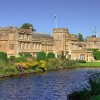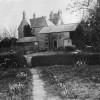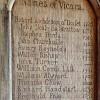West of the county town of Dorchester is an area known as the Bride Valley. Here, tucked-up in the shadow of Old Warren, a hill rising to 250 feet and thought to be an Iron Age fort, is the picturesque village of Little Bredy.
Nearby is the Valley of Stones, well known for the many boulders strewn along its floor and slopes. From here came the material for the stone circles and numerous chambered tombs in the vicinity: two thirds of all Dorset’s monuments of this type are to be found within four miles of this valley. Our ancient forefathers left us tantalising glimpses into how they lived and throughout Dorset their monuments remain standing, challenging us to discover there significance, though some have fallen in disarray.
Presently home to about 85 people, the village and parish of Little Bredy has a long history. The Domesday Book records the manor of Litelbidia being held by The Abbey of Cerne and this continued until the dissolution of the monasteries. Phillip Vanwilder acquired the manor only to sell it on in 1584 to Robert Freke of Iwerne Courtney, who, in turn conveyed it to Robert Mellor, the husband of his daughter, Margaret. Robert Mellor was from Came. Towards the end of the reign of Elizabeth I Robert Mellor built a house on the site where the present Bridehead House stands. Robert was succeeded by Sir John Mellor, a supporter of Charles I during the Civil War, who left the manor and house to his youngest son, Robert, who died at Little Bredy in 1655; he was buried at Came, continuing a family tradition. Robert Mellor’s widow left the manor and house to her son Edward who moved away to Buckinghamshire. Before he died in 1699 he sold off some of the family’s Dorset property to pay off debts; it is known that at this time the house at Little Bredy was burdened by mortgages. The Bridges family, who were tenant farmers, moved into the property, which was eventually sold with the manor, by the Mellor family in 1730 to William Meech of Charminster. The Bridges farming family continued to live in the house throughout the 18th century. They were buried in the Little Bredy churchyard and there are memorials to them in the church. In 1798 John Meech, the grandson of William, sold the estate.
The purchaser was Robert Williams of Hertfordshire; his family were originally from Winterborne Herringston in Dorset. The new owner was a wealthy London banker, the senior partner in Williams and Deacon’s Bank. He owned a large property portfolio as well as a fleet of ships to facilitate his trading interests in the Indies.
Over four generations the Williams family brought many changes to Little Bredy. During the 19th century the house, Bridehead, was expanded and a lake was made by the damming of the spring forming the source of the River Bride. Old cottages belonging to the estate were improved and a school was built. A look at the census record for 1851 gives some idea of the status of the Williams family. Besides himself he was host to thirteen relations, all served by some twenty servants. The line of four Robert Williams to own Bridehead all became Members of Parliament. The last Robert Williams became the 1st Baronet of Bridehead.
The parish church is dedicated to St. Michael and All the Angels. In 1847 the villagers were asked to put-up a small team of builders who had been drafted in to restore the medieval church. This resulted in it being rebuilt with only the tower and a part of the chancel, including some of the original medieval windows, surviving. The architect was Benjamin Ferry, no stranger to Victorian Dorset where he had restored many churches. But on this occasion he was only responsible for the design; the architect on site was Arthur Acland, the brother-in-law of Robert Williams, who commissioned and paid for the work. The nave was replaced and extensions to the north and south aisles were added. The original tower was reinforced to take a steeple and four new bells were added to the existing two. The memorials to the Bridge family were re-set into the south walls of the new nave.
The Bride Valley is a peaceful and picturesque area where rural life goes on at a pace dictated by the seasons and the stone circles, monoliths and numerous barrows continue to keep our forefather’s secrets.



